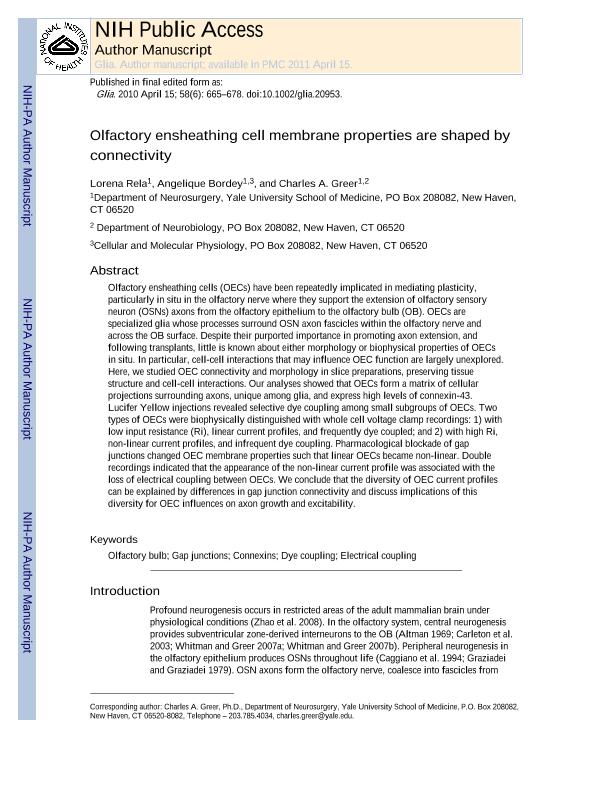Mostrar el registro sencillo del ítem
dc.contributor.author
Rela, Lorena

dc.contributor.author
Bordey, Angelique
dc.contributor.author
Greer, Charles A.
dc.date.available
2017-05-11T18:55:28Z
dc.date.issued
2010-04
dc.identifier.citation
Rela, Lorena; Bordey, Angelique; Greer, Charles A.; Olfactory ensheathing cell membrane properties are shaped by connectivity; Wiley-liss, Div John Wiley & Sons Inc; Glia; 58; 6; 4-2010; 665-678
dc.identifier.issn
0894-1491
dc.identifier.uri
http://hdl.handle.net/11336/16322
dc.description.abstract
Olfactory ensheathing cells (OECs) have been repeatedly implicated in mediating plasticity, particularly in situ in the olfactory nerve where they support the extension of olfactory sensory neuron (OSNs) axons from the olfactory epithelium to the olfactory bulb (OB). OECs are specialized glia whose processes surround OSN axon fascicles within the olfactory nerve and across the OB surface. Despite their purported importance in promoting axon extension, and following transplants, little is known about either morphology or biophysical properties of OECs in situ. In particular, cell-cell interactions that may influence OEC function are largely unexplored. Here, we studied OEC connectivity and morphology in slice preparations, preserving tissue structure and cell-cell interactions. Our analyses showed that OECs form a matrix of cellular projections surrounding axons, unique among glia, and express high levels of connexin-43. Lucifer Yellow injections revealed selective dye coupling among small subgroups of OECs. Two types of OECs were biophysically distinguished with whole cell voltage clamp recordings: 1) with low input resistance (Ri), linear current profiles, and frequently dye coupled; and 2) with high Ri, non-linear current profiles, and infrequent dye coupling. Pharmacological blockade of gap junctions changed OEC membrane properties such that linear OECs became non-linear. Double recordings indicated that the appearance of the non-linear current profile was associated with the loss of electrical coupling between OECs. We conclude that the diversity of OEC current profiles can be explained by differences in gap junction connectivity and discuss implications of this diversity for OEC influences on axon growth and excitability.
dc.format
application/pdf
dc.language.iso
eng
dc.publisher
Wiley-liss, Div John Wiley & Sons Inc

dc.rights
info:eu-repo/semantics/openAccess
dc.rights.uri
https://creativecommons.org/licenses/by-nc-sa/2.5/ar/
dc.subject
Olfactory Bulb
dc.subject
Gap Junctions
dc.subject
Connexins
dc.subject
Dye Coupling
dc.subject
Electrical Coupling
dc.subject.classification
Neurociencias

dc.subject.classification
Medicina Básica

dc.subject.classification
CIENCIAS MÉDICAS Y DE LA SALUD

dc.title
Olfactory ensheathing cell membrane properties are shaped by connectivity
dc.type
info:eu-repo/semantics/article
dc.type
info:ar-repo/semantics/artículo
dc.type
info:eu-repo/semantics/publishedVersion
dc.date.updated
2017-05-10T19:59:44Z
dc.journal.volume
58
dc.journal.number
6
dc.journal.pagination
665-678
dc.journal.pais
Estados Unidos

dc.journal.ciudad
Malden
dc.description.fil
Fil: Rela, Lorena. University of Yale; Estados Unidos. Consejo Nacional de Investigaciones Científicas y Técnicas; Argentina
dc.description.fil
Fil: Bordey, Angelique. University of Yale; Estados Unidos
dc.description.fil
Fil: Greer, Charles A.. University of Yale; Estados Unidos
dc.journal.title
Glia

dc.relation.alternativeid
info:eu-repo/semantics/altIdentifier/url/https://www.ncbi.nlm.nih.gov/pmc/articles/PMC2830329/
dc.relation.alternativeid
info:eu-repo/semantics/altIdentifier/doi/http://dx.doi.org/10.1002/glia.20953
dc.relation.alternativeid
info:eu-repo/semantics/altIdentifier/url/http://onlinelibrary.wiley.com/doi/10.1002/glia.20953/abstract
Archivos asociados
